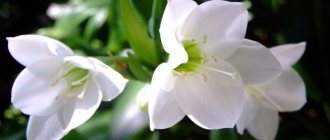However, for an indoor rose to take root, it will take a lot of effort. In the article we will talk about the basic rules for caring for indoor roses at home, the characteristics of the plant, the main varieties, methods of propagation and problems that can arise from improper maintenance.
Botanical description
Rose (Rosa) is a beautiful flowering shrub that belongs to the Rosaceae family. There are high (50-70 cm), low (10-30 cm) and medium (30-50 cm) shrubs .
Most varieties of indoor roses are heat-loving, but there are also varieties that are not picky about temperature conditions.
The shoots of the rose are straight or arched, covered with thorns. The leaves are compound, carved at the edges, imparipinnate. Flowers with a double perianth have a variety of sizes - from 1 to 16 cm in diameter. They can be either single or collected in inflorescences. Each flower contains many stamens and pistils.
The variety of colors is amazing. This plant has a huge number of shades: white, pink, yellow, purple, pink, scarlet, green. Roses are also famous for their pleasant aroma .
Indoor roses will delight you with their flowering if you provide them with good lighting, careful watering and timely pruning. Cut flowers can last in a vase for 5 to 10 days.
Appearance
Now the appearance of a hybrid tea rose is as follows: it is a bush or standard tree with long flowering shoots. Each resulting flower is a work of art. Its elongated bud with a sharp tip, opening, reveals numerous satin or velvet petals with neatly curved edges, curled in the center into a high cone. The variety of petal colors and scents is amazing. The flowers are either medium-sized or larger, beautiful, with numerous petals forming a clearly visible central cone. Usually the flowers are single or with several lateral buds.
This may be interesting: How to care for indoor Gerbera
Varieties and photos
Below are photos, names and descriptions of indoor rose varieties suitable for propagation and care at home:
Baby Masquerade
This variety should be classified as a medium-sized shrub. Its height varies from 30-40 cm. It is noteworthy that Baby Masquerade has practically no thorns and powerful shoots of a dark green color.
The peculiarity of the variety is the ability of the flowers to change their color during flowering. Lemon buds change to pinkish, and at the end of flowering they become scarlet. Baby Masquerade smells pleasant and is resistant to fungal diseases, and therefore is a favorite among many other varieties. The photo below shows the Indoor Rose Baby Masquerade:
Angela Rippon
It belongs to a variety of miniature indoor plants, but despite this it is distinguished by a large number of fragrant flowers. Up to 5 buds are formed in one inflorescence. The maximum height of the bush is 40 cm. The variety is not demanding when it comes to pruning and is often susceptible to various diseases. You can see what the variety Indoor rose Angela Rippon looks like in the photo below:
This variety should be grown in small pots and fertilized frequently, including foliar feeding.
Fire Princess
The variety attracts the eye with its orange-red flowers framed by dark green foliage. The bushes are medium in size, the shoots are straight. Fire Princess is prone to fungal diseases and needs timely treatment with special preparations.
Hummingbird (Colibri)
The name of the variety is not accidental, because... has small bushes about 30 cm in height. However, its small size does not in any way affect its decorative effect. Hummingbird is famous for its rather large flowers - about 4-5 cm . with a pleasant aroma. The leaves are glossy and green very densely covering each stem. The flowers have an unusual color - from apricot to yellow.
Yellow Doll
This variety will not leave any gardener indifferent. The shrub is famous for its lush lemon-colored flowers. Each flower is crowned with a large number of petals - there are about 50 of them. Yellow Doll is very compact - only about 30 cm. In the photo below, the variety Indoor Rose Yellow Doll:
Green Ice
If you want to purchase a flowering rose variety, choose Green Ice. The shrub will not only delight you with its impressive size (about 60-65 cm), but also with year-round flowering. This variety is resistant to fungal diseases and does not require painstaking care. Despite the fact that Green Ice buds are pink, blooming roses become white with a greenish center. Each inflorescence produces from 2 to 5 flowers.
Bonus feeding
It is often recommended to feed roses in the same way as any other beautifully flowering houseplant - during the period of active growth. Usually - in spring and summer or from the moment new leaves and shoots begin to grow until the end of the flowering period.
For them, the standard feeding frequency is once every 2 weeks. But in order to achieve maximum effectiveness from roses and preserve plants from year to year, you should not limit yourself to just the usual approach. A few additional procedures and a little trick of reducing the frequency will allow you to satisfy all the needs of roses without the risk of overfeeding or underfeeding.
Indoor roses, indeed, can be fed once every 2 weeks with complex fertilizers, if desired, changing their composition at the stage of budding and flowering. But roses respond much better to weekly feeding. It is better to carry them out separately with mineral and organic fertilizers, using half the usual dose. Special fertilizers for roses are quite suitable for the mineral “stage”.
Another strategy can be applied. At the very beginning of growth for a month, it is better to feed roses with complete mineral fertilizers or fertilizers with a high nitrogen content. At the stage of formation of buds, roses need potassium-phosphorus fertilizing, which can be continued at the beginning of flowering and until its middle, then again returning to balanced fertilizers.
It is better to choose fertilizers in liquid form and store-bought preparations with well-known properties for indoor roses, especially when it comes to organic fertilizers.
Conventional fertilizers for indoor roses are not enough. Foliar feeding is a guarantee of both better budding and lush greenery of the bushes. They are the ones who allow roses to look so luxurious on the shelves. Foliar feeding is carried out only 3 or 4 times, at equal intervals of 10 to 12 days, throughout the spring, starting from the moment when young branches begin to actively grow.
Indoor roses are great lovers of fresh air. k.sina
Care
House roses are quite demanding in terms of maintenance conditions. Many plants die immediately after being purchased and placed in a different microclimate. Therefore, we strongly recommend that you read the information regarding care.
How to care after purchase?
In the store, a rose usually looks beautiful and healthy, so when it comes home, the new owner thinks that no effort will be required from him to maintain the appearance of the flower. This opinion is wrong, because in the store the rose is fed with special additives , and if it gets into a different microclimate, the flower may die.
In most cases, yellowing of the foliage and blackening of the buds is observed, and then the death of the plant, even if the rose looked healthy and strong.
Any varieties of roses are intended for keeping in open ground. Some varieties have been “domesticated”, but growing indoors always poses considerable difficulties.
Immediately after purchasing a shrub, you should perform a number of actions:
- Remove the gift wrapping - it can interfere with proper air exchange and cause the development of dangerous fungus.
- Dry and blackened shoots, as well as limp leaves should be removed.
- Buds and flowers also need to be cut off, because... In most cases, their flowering is created artificially; the plant spends its energy on flowering, and then dies.
- Look how many bushes are in the pot, because... Often, to create the effect of a lush bush, several plants are planted in a pot at once, which interfere with each other. Therefore, if several shrubs are found, they should be planted in separate containers.
After transplantation, the shrubs will need treatment against fungal infections using Fitosporin, as well as prevention of pests with Fitoverm solution.
Lighting
It is better to place an indoor rose on a south window, because... the plant is demanding of light. Otherwise, the shrub will bloom poorly. At the same time, avoid direct sunlight and be sure to shade the window during the period of “active” sun.
In winter, in the absence of proper lighting, lighting with phyto lamps will be required.
Temperature
During the period of active growth, indoor roses will need at least 20-25 degrees of heat, but during the dormant period, 5-8 degrees will be enough. With the onset of spring, the temperature will need to be increased gradually.
Roses by nature love open ground, so in the summer, if possible, place the pot on the balcony or in the garden . Be sure to ventilate the room with the flower, avoiding drafts.
Humidity and watering
Watering must be adjusted from the very first days.
In summer it should be more abundant, in winter - a little less. Remember that the earthen ball should always remain slightly moist, otherwise the rose may shed its leaves. To avoid harming the plant, use settled water at room temperature, including for spraying.
Watering methods should be alternated , the first time watering the plant at the root, and the next watering in the pan. Excess water must be drained.
It is also necessary to maintain a high level of air humidity - at least 60-65%. Otherwise, the bush will be attacked by pests. In sunny weather, you should not spray the rose - this way you risk getting burns on the leaves. But in winter, the shrub needs to be moistened regularly or the pot should be placed on a tray with wet expanded clay.
Top dressing
Fertilizing an indoor rose should be carried out according to the following rules:
- in winter and during quarantine the flower is not fertilized;
- during flowering, frequent feeding will be needed - every 12-15 days;
- use both mineral and organic fertilizers, alternating them with each other.
Expert opinion
Vera Ivanovna Sh
Since childhood, I have been interested in growing indoor flowers, then I decided to devote my life to landscape design and gardening.
For mineral fertilizers, you will need special fertilizers purchased in the store. You can prepare organic fertilizers yourself using a solution of cow or bird droppings in a ratio of 1:10.
How to transplant?
We carry out the transplant as follows:
- Carefully remove the bush from the pot so as not to damage the roots.
- We place drainage consisting of pebbles or expanded clay in a pre-purchased container of larger diameter.
- We fill in the soil mixture and compact it well.
- We transplant the old plant into the middle of the container and, if necessary, add a little more soil.
- We water the rose generously, after which we treat it with Epin so that the plant can more easily adapt to the new environment.
- If the bush is small, cover it with polyethylene for speedy rooting.
We carry out subsequent care in the usual way.
Priming
The growth and health of indoor roses depends on the composition of the soil. You can purchase a ready-made substrate or make it yourself.
There are 2 options for preparing soil mixture , take the following components:
- 1 part of coniferous land;
- 1 part humus;
- 1 part sand;
- 1 part leaf soil;
- 3 parts of turf land.
Second option: 4 parts of turf soil and the same amount of humus, and then add 1 part of sand.
Pot
To grow a flower and actively grow, you will need a wide pot, because... in a small pot, the roots will not be able to develop normally and absorb nutrients from the soil.
Trimming
Timely, correct pruning helps to form a beautiful, healthy bush. The procedure is carried out during bud formation, as well as immediately after flowering. There are several pruning rules:
- branches growing inside the bush must be removed;
- weak and thin shoots also need to be pruned;
- faded flowers need to be cut off at the level of the first leaf - at the location of the bud;
- The branches need to be trimmed correctly, leaving 4-5 buds on them.
Transplanting an indoor rose
When replanting an indoor rose, it must be carefully removed from the old pot, and it must be taken along with a lump of earth. Then they carefully examine the root system, which entwines the earthen ball. If the roots are thin, similar in appearance to hairs, black or brown, rotten or dried out, then this means that the bush will soon die. However, you can try to save the rose; to do this, you should cut cuttings that will need to be rooted.
If the roots are healthy, they will have a pale yellow or deep white color; they are very dense and thin, similar to wire. If only part of the roots has dried or rotted, then it should be removed, leaving only healthy ones.
To plant, you need to take a new flower pot, and make a good drainage layer at the bottom; for this you can use expanded clay or other material. For replanting, you need to use a soil mixture that is intended for roses or a garden soil. An inexpensive soil mixture will not be suitable for these purposes, since it contains a large amount of peat, but very few useful substances. Experts recommend using only high-quality soil mixture. The substrate for planting such a plant, if desired, can be made with your own hands; for this, coniferous and leaf soil, humus, sand and turf soil are combined (1: 1: 1: 1: 3).
The drainage layer must be covered with a layer of soil, which is compacted. Place a bush in the container, taken together with a lump of earth, all the voids must be filled with fresh substrate, and it should be systematically compacted, since the rose should not dangle in the container, but must be securely fixed. To water the transplanted bush, you should use filtered or settled water at room temperature.
The bush must be treated against diseases and harmful insects. After transplantation and pruning, the rose becomes very weak and is easily affected by various diseases. In this regard, experienced gardeners recommend treating the bushes for preventive purposes.
It is recommended to spray the replanted plant with Epin, which will make the plant’s immunity much stronger and also reduce the stress of replanting. The bush must be regularly moistened with a sprayer, since it needs high humidity, especially in conditions of operating heating or too dry air. It is recommended to cover a small and weakened bush on top with a cut-off bottle with small holes. Thanks to this, it will be possible to create greenhouse conditions, and after the plant takes root, it is gradually accustomed to indoor conditions.
After the transplant is completed, the container with the flower is placed on a well-lit windowsill. If there is no sunny window sill in the apartment, then the bush will need additional illumination with fluorescent lamps. Additional lighting will also be needed in winter.
Transplanting indoor roses.
Reproduction
The rose is propagated by cuttings, which can take root in several ways. For planting , select lignified shoots up to 15 cm long . and separate them from the mother bush. Make sure that there are at least two buds on each cutting.
In water
For rooting in water, you will need annual shoots, which are prepared immediately after flowering. The procedure is as follows:
- Place the cuttings in a prepared container with water.
- Wait for the roots to form.
- Place the cuttings in pre-moistened potting soil and care for them as you would for adult plants.
In order for the cuttings to take root, it is necessary to provide them with a large amount of light, and periodically add water to the container.
In potatoes
To get a new plant, you will need 1 medium tuber. Make a hole in it and place the cutting there . The tuber itself should be planted in moistened sand, leaving the upper part on the surface. Cover the cutting with a plastic bottle or glass jar on top, water and ventilate the plant regularly.
In the substrate
To strengthen the cuttings in the soil and get new plants, you need to:
- Prepare a substrate from a mixture of humus and peat in equal proportions.
- Plant the cuttings, sprinkling them with sand on top.
- Cover the plants with a jar.
- As soon as the first leaves and roots appear, transplant into separate containers.
Difficulties encountered by beginning flower growers
When growing indoor roses, gardeners face problems. However, they can be eliminated.
Yellowing of leaves
Yellowing of the foliage on the bush occurs due to a disruption in the production of chlorophyll (green pigment). The causes of the violation are considered to be violations of maintenance conditions, pest damage, damage to roots and a lack of nutrients. If you identify what led to the violation, you can eliminate the problem with treatment, sanitization, or changing conditions.
Wilting and darkening of foliage
If the leaves dry out or change their shade, it can be assumed that the root system is rotting. The problem can be solved by replanting the bush with preliminary cleaning of the rhizomes from the old soil. If the lesions are extensive, the roots should be shortened to healthy tissue and washed in a manganese solution. After disinfection, the rose is transplanted into a new container with soil.
Drying leaves sometimes cause nutrient deficiencies. In this case, the plant should be fed with fertilizers.
Diseases and pests
Harmful insects often attack this beautiful and fragrant flower. In addition to pests, there is a danger of developing various diseases. Their presence is associated with improper conditions of detention. Therefore, every gardener should know what measures should be taken when certain signs appear.
Why do the leaves turn yellow?
Yellowing of the leaves of a rose indicates an excess of water in the pot. This can be either improper watering or stagnation of moisture in the roots of the plant. In this case, it is important to pay maximum attention to the flower: watering must be reduced and the rose must be allowed to adapt ; only the leaves can be moistened. If the soil is acidic, the bush must be transplanted into new soil.
To strengthen the immunity of yellowed shrubs, use complex fertilizers such as Greenward and Bona Forte.
Leaves are drying
Typically, the leaves of the plant dry out in winter, when the air in the apartment becomes too dry. In summer, during extreme heat, this behavior of the bush is also possible. In addition, the leaves of an indoor rose can dry out for a number of reasons:
- the root system is damaged;
- the soil does not receive enough moisture;
- the pot is located in close proximity to the radiator.
To restore the bush it is necessary to water it and also moisten it with a sprayer . If watering does not produce results, you need to check the roots for damage and, if necessary, separate the cuttings for seedlings.
The leaves are falling
Leaves may fall for several reasons:
- the plant was attacked by pests;
- an indoor rose sheds its leaves if it lacks warmth or there are drafts in the apartment;
- the bush is affected by a fungal or viral infection;
- Cold water was used for irrigation.
If you notice falling leaves on an indoor rose, you should take the following measures:
- damaged leaves are removed;
- inspect the surface of damaged leaves;
- when pests are detected, Fitoverm is used;
- in the presence of diseases (they can be identified by the characteristic mosaic on the leaves), special preparations are used, for example, “Fitosporin”.
White coating on leaves
This sign directly indicates the development of a fungal infection . In addition to plaque, plaques and growths may appear on the bush, and the leaves may become covered with small spots. To cure the plant, you will need to spray it with a solution of Fitosporin.
Why doesn't it bloom?
Sometimes it happens that the bush does not bloom. This is possible for a number of reasons:
- lack of proper fertilizing;
- insufficient lighting;
- the plant has not rested from the previous flowering;
- in case of untimely pruning.
Spider mite
This parasite appears when the air in the room is too dry.
Spider mites entangle the entire bush, sucking nutrients from it. The leaves of the plant turn yellow, wither, and then die. One of the measures to prevent ticks is a warm shower , which should be periodically given to indoor roses, after covering the soil with polyethylene. In difficult cases, this pest is destroyed with an insecticide solution.
As soon as you find a spider mite, the flower pot should be placed in “quarantine” - separately from other plants in the house. Don't forget to inspect the flowers adjacent to it.
Powdery mildew
White coating on the leaves and stems of indoor roses is direct evidence of the appearance of powdery mildew. This disease threatens with blackening of parts of the bush and subsequent death. If the plaque is small, spray the flower with a soda solution (2 teaspoons of soda per 1 liter of water). If the infestation is severe, fungicide treatment will be required.
Aphid
The appearance of aphids occurs when the plant’s immunity is weakened. reducing the high temperature in the room to normal and maintaining the necessary air humidity will come to the rescue
Expert opinion
Vera Ivanovna Sh
Since childhood, I have been interested in growing indoor flowers, then I decided to devote my life to landscape design and gardening.
Spraying the plant against pests with insecticides should be done outdoors in the shade. And only after a day can the pot be returned to its original place, otherwise you risk getting poisoned. Also remember to use gloves and an aspirator.
An indoor rose is perfect as a gift for any occasion. With proper care at home, an indoor rose will retain its attractive appearance, and after a while, new plants can be obtained from the bush. The main thing is not to neglect the rules of care presented in the article.
How to care for a homemade rose in a pot after purchase
Small roses in pots are a popular product in flower shops. What to do when the plant is at home? First of all, it should be remembered that specimens brought from abroad are often found in transport soil and have been intensively sprayed with growth stimulants. Therefore, it is advisable to replant 2 weeks after purchase (when the flower has come to its senses a little) into suitable soil and be patient until the rose adapts to the new environment.
We also recommend reading:
16 most popular indoor plants Physalis: description of species and varieties, technology for growing from seeds Spruce in landscape design: the best ornamental varieties and characteristics of cultivation Kalanchoe: description of types and characteristics of care at home
Simple protection against incorrect temperatures
Despite the fact that indoor roses are quite sensitive to incorrect temperatures, they can be compensated for with care and additional procedures. It is care and careful observation of the plant that is the main guarantee that roses in potted format will remain healthy.
There are only two treatments that will help roses cope with hotter temperatures:
- spraying, which can be included in the care program when the temperature rises to 24 degrees or more (in summer it is carried out several times a day);
- ventilation of rooms (protecting the plant from drafts and sudden temperature changes in the form of a protective shelter or temporary transfer to a new location).
But it’s easier to deal with lower, too cold values: the plant is simply moved to a warmer room. In winter, if roses are kept at temperatures below 10 degrees, plants are saved from hypothermia and the risk of temperatures falling below 3 degrees by using additional insulation of containers or a temporary cap
As temperatures rise, it is important to protect roses from sudden changes, slowly changing the temperature to reduce stress
Any extremes of hypothermia or overheating of the soil are very dangerous for roses. And while the temperature in the room is easily equalized by timely measures taken, with the substrate everything is more difficult. Any contact with cold surfaces, including glass or a window sill, without a protective stand during the cold season can lead to partial supercooling of the substrate.
On hot days in summer, the soil must be protected from overheating, including through the use of double containers and wrapping materials that stabilize the temperature of the substrate inside the main pot.
To stabilize the temperature, roses are watered with slightly lukewarm water - 2-4 degrees above the temperature in the room. In summer, if the rooms are very hot, the water temperature can be lowered by 2-3 degrees, but only as a last resort and without creating a temperature shock for the roots of the plant.











